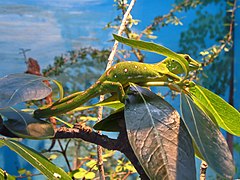Naultinus: Difference between revisions
GrahamBould (talk | contribs) No edit summary |
GrahamBould (talk | contribs) No edit summary |
||
| Line 42: | Line 42: | ||
* [http://zipcodezoo.com/Key/Naultinus_Genus.asp ZipCodeZoo] |
* [http://zipcodezoo.com/Key/Naultinus_Genus.asp ZipCodeZoo] |
||
[[Category:Naultinus]] |
[[Category:Naultinus| ]] |
||
[[Category:Reptiles of New Zealand]] |
[[Category:Reptiles of New Zealand]] |
||
Revision as of 00:41, 12 December 2008
| Naultinus | |
|---|---|

| |
| Naultinus grayii | |
| Scientific classification | |
| Kingdom: | |
| Phylum: | |
| Class: | |
| Order: | |
| Family: | |
| Genus: | Naultinus Gray, 1842
|
| Species | |
|
See text | |
Naultinus is one of two genera of geckos in New Zealand, the other being Hoplodactylus. Naultinus species are commonly known as "Green Geckos". All Green Geckos are both arboreal and predominantly green but can be plain, spotted or striped, and occasionally overall lemon yellow (in varying shades). Since they are also diurnal, they are generally more frequently seen in the native forest ecosystems than their predominantly nocturnal relatives in the Hoplodactylus genus.
None of the Naultinus gecko populations are sympatric, presumably because each species is adapted to its local environment and also because their respective ecological niches are incredibly similar.[1] Naultinus species also possess prehensile tails as an adaptation to their habitat. They are more reluctant to shed their tail when disturbed by a predator than Hoplodactylus. They also have comparatively slender toes, another adaptation to their arboreal lifestyle.
Unlike their close relatives in the Hoplodactylus genus, Naultinus species lack the ability to alter their skin color. In addition to chirping and or chattering communication calls, green geckos can also produce a loud croak or "bark" of alarm or distress. Coupled with the vivid coloration (bright red, deep blue) of the interior of the mouthes, some Naultinus species use this as a defensive behavior to scare off predators.
Species
- Auckland green gecko, Naultinus elegans elegans
- Wellington green gecko, Naultinus elegans punctatus
- Jewelled gecko, Naultinus gemmeus
- Northland green gecko, Naultinus grayii
- Marlborough green gecko, Naultinus manukanus
- Lewis Pass green gecko, Naultinus poecilochlorus
- Rough gecko, Naultinus rudis
- Nelson green gecko, Naultinus stellatus
- West Coast green gecko, Naultinus tuberculatus
References
- ^ Rob Hitchmough- Threatened species science section, DOC, (August 2006)
- New Zealand geckos; A guide to captive maintenance and breeding, RPV Rowlands, Ecoprint, 1999
- New Zealand frogs and reptiles, Brian Gill and Tony Whitaker, David Bateman publishing, 1996
